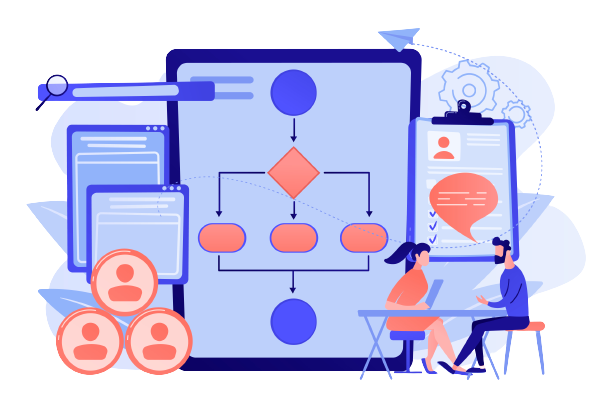
In modern business, the path to success is often paved with intricate processes, data streams, and a whirlwind of tasks that require careful orchestration. Picture your business operations as a grand symphony – each department and function playing a vital note to create a harmonious outcome. But what happens when this symphony becomes a cacophony, with disjointed tasks, missed opportunities, and inefficiencies? Enter the hero of the story: Effortless CRM Workflow Automation.
In a world where time is a precious commodity and precision is non-negotiable, the ability to seamlessly move from one task to another, from lead generation to nurturing, from prospecting to conversion, holds the key to unlocking your business’s full potential. This blog embarks on an illuminating quest to unveil the inner workings of CRM workflows – those intelligent pathways that elegantly guide data, communication, and actions, transforming intricate processes into effortless maneuvers.
We will discuss the fundamental concepts that underscore CRM workflow automation, demystify the technical jargon, and lay out a roadmap that navigates you from disorder to a realm of structured elegance. Each section of this journey will illuminate a new facet – from understanding the core principles to designing workflows that cater to your unique business intricacies.
But why does this matter? The answer lies in the remarkable transformation that occurs when your business evolves from managing tasks to optimizing processes. Effortless CRM workflow automation holds the potential to skyrocket your business performance – to amplify your efficiency, elevate your customer interactions, and drive results that defy expectations.
So, whether you’re an entrepreneur charting the course for your startup, a seasoned business owner seeking to revolutionize your operations, or a curious mind intrigued by the alchemy of efficient workflows, this blog is your compass. It’s a comprehensive guide that empowers you to reclaim control, infuse structure, and witness the magic of turning a mess into smooth processes – all powered by the artful mastery of CRM workflow automation.
Understanding CRM Workflows: A Beginner’s Guide

CRM workflows serve as the backbone of efficient customer relationship management, enabling businesses to streamline processes, enhance communication, and ultimately improve business performance. If you’re new to the concept, let’s break it down.
At its core, a CRM system is software that helps businesses organize and manage interactions with customers and potential clients. A CRM workflow, then, refers to the series of steps and automated actions that guide how data and tasks flow through your CRM system. Think of it as a well-orchestrated dance where each step is carefully choreographed to ensure a seamless and efficient process.
When a lead is generated, for example, a CRM workflow can automatically assign it to a sales representative, trigger a follow-up email, and schedule a reminder for a phone call. As the lead progresses through the sales funnel, the CRM workflow automation can automatically update the status, notify the team, and generate reports for analysis.
Why Effortless CRM Workflows Matter for Your Business?

Effortless CRM workflows and CRM workflow automation can make a significant impact on your business’s bottom line. Here’s why they matter:
- Enhanced Efficiency: Manual tasks and data entry can be time-consuming and prone to errors. With well-designed CRM workflows, these tasks can be automated, freeing up your team to focus on more valuable activities.
- Consistent Customer Experience: When processes are standardized through CRM workflows, customers receive a consistent experience every time they interact with your business. This consistency builds trust and loyalty.
- Reduced Bottlenecks: A streamlined workflow ensures that tasks move smoothly from one stage to the next, reducing bottlenecks and preventing delays. This leads to quicker response times and improved customer satisfaction.
- Data-Driven Insights: CRM workflow automation capture data at every step. This data can then be analyzed to gain insights into customer behavior, preferences, and pain points, enabling you to make informed decisions.
The Connection Between Smooth Processes and Improved Business Performance

The relationship between smooth processes and business performance is akin to a well-oiled machine. Just as a machine functions optimally when all its parts work seamlessly together, a business operates at its best when its processes are smooth and efficient.
Smooth CRM workflows and their automation play a pivotal role in this equation. They eliminate redundancies, ensure consistent follow-ups, and prevent critical tasks from falling through the cracks. As a result, your team can allocate their time and resources more effectively, leading to increased productivity.
Furthermore, improved business performance is directly tied to customer satisfaction. A seamless customer experience, facilitated by CRM workflows, enhances customer satisfaction and loyalty. Satisfied customers are more likely to become repeat buyers and advocates for your brand.
Basically, CRM workflow automation is not just about organizing tasks; they’re about creating a foundation for excellence. By optimizing your processes through efficient workflows, you’re setting the stage for improved business performance, growth, and success. In the upcoming sections, we’ll delve deeper into the building blocks of effective CRM workflows and how they contribute to the success of your business.
Building Blocks of Effective CRM Workflows

Building a well-designed CRM workflow involves understanding key elements, mapping out the process, and integrating automation for a seamless and streamlined experience. Let’s explore each element of CRM workflow automation in detail.
1. Key Elements of a Well-Designed CRM Workflow:
A well-designed CRM workflow is like a well-orchestrated symphony, where each element plays a crucial role in creating a harmonious result. Here are the key elements that contribute to effective CRM workflow automation:
- Clear Objectives: Define the purpose and goals of the workflow. Are you automating lead generation, customer onboarding, or support ticket management? Having clear objectives ensures that your workflow aligns with your business goals.
- User-Friendly Interface: Your CRM workflow should be intuitive and user-friendly for all team members involved. A user-friendly interface minimizes the learning curve and encourages adoption.
- Defined Steps: Break down the workflow into distinct steps. Each step should have a specific purpose and contribute to the overall process. This clarity helps in smooth execution and accountability.
- Data Integration: Seamlessly integrate data from various sources and departments. Data integration ensures that the right information is available at each step, enhancing decision-making and customer interactions.
- Communication Channels: Determine the communication channels used at each stage. Whether it’s email notifications, SMS alerts, or in-app messages, clear communication channels keep everyone informed.
- Roles and Responsibilities: Assign roles and responsibilities to team members. Each person involved should know their role in the workflow, reducing confusion and preventing bottlenecks.
- Feedback Loops: Build in feedback loops to gather insights from team members and customers. Regular feedback helps in refining the workflow and adapting to changing needs.
2. Mapping Out Your CRM Workflow: Step-by-Step Process:
Mapping out your CRM workflow is a critical step that lays the foundation for a successful implementation. Here’s a step-by-step guide to help you map out your CRM workflow automation:
- Identify the Process: Determine the process you want to automate. It could be lead management, sales follow-ups, or customer support.
- Define Steps: Break down the process into sequential steps. For instance, in lead management, steps could include lead capture, lead qualification, and lead nurturing.
- Sequence and Dependencies: Arrange the steps in the correct sequence and identify any dependencies. Certain steps might be contingent on the completion of others.
- Decision Points: Identify decision points where different paths might be taken based on specific conditions. Decision points allow for customization and personalization.
- Communication: Determine how communication will flow within the workflow. Who receives notifications, and at what stage?
- Testing and Optimization: Before implementation, run a test simulation of the workflow to identify any gaps or areas for improvement. Optimize the workflow based on the test results.
3. Integrating Automation for Seamless CRM Workflows:
Automation is the backbone of a seamless CRM workflow. It reduces manual intervention, minimizes errors, and ensures consistent processes. Here’s how to integrate CRM workflow automation effectively:
- Identify Automation Opportunities: Identify tasks that can be automated, such as sending follow-up emails, assigning leads, or updating customer records.
- Choose the Right Tools: Select CRM software that offers robust automation capabilities. Look for features like workflow builders, triggers, and timers.
- Design Workflows: Use the chosen CRM’s automation tools to design workflows based on the mapped-out process. Set triggers to initiate actions based on specific events or conditions.
- Testing and Validation: Before deploying, thoroughly test the automated workflow to ensure it functions as intended. Validate each step and decision point.
- Monitor and Refine: Once implemented, continuously monitor the automated workflow. Collect data on performance, engagement, and efficiency. Refine the workflow based on insights.
Think of, a well-designed CRM workflow automation that evolves with your business needs. Regularly assess its effectiveness and make adjustments as your processes and objectives change over time. Building effective CRM workflows requires careful planning, attention to detail, and a commitment to continuous improvement.
Benefits of Streamlined CRM Workflows for Business Performance

Streamlined CRM workflows offer numerous benefits that significantly enhance business performance. By automating manual tasks and optimizing processes, efficiency, and productivity are greatly improved. These workflows ensure tasks are assigned, prioritized, and executed systematically, fostering better collaboration among team members.
Moreover, streamlined CRM workflows lead to faster response times, personalized customer interactions, and seamless follow-ups, ultimately boosting customer satisfaction. The quantifiable impact of these optimized workflows is evident through enhanced metrics tracking, improved reporting, and cost savings, which collectively contribute to better business performance, increased customer loyalty, and a competitive edge in the market.
How Smooth CRM Workflows Enhance Efficiency and Productivity?
Efficiency and productivity are crucial factors that determine the success of any organization. Streamlined CRM workflows play a pivotal role in driving these aspects to new heights. Let’s delve into how smooth CRM workflow automation enhances efficiency and productivity within your business:
1. Reduction of Manual Tasks: One of the significant benefits of a well-designed CRM workflow is the automation of manual tasks. Repetitive and time-consuming activities, such as data entry, lead assignment, and follow-up emails, can be automated, freeing up your team’s time for more strategic and value-added tasks.
2. Improved Task Prioritization: With a clear and structured CRM workflow automation, tasks are assigned and prioritized systematically. This ensures that your team focuses on the most critical activities, avoiding confusion and minimizing the risk of important tasks falling through the cracks.
3. Seamless Collaboration: Streamlined workflows facilitate better collaboration among team members. Clear guidelines and automated notifications ensure that everyone is on the same page, reducing miscommunication and enhancing cross-functional teamwork.
4. Faster Response Times: Effortless CRM workflows enable quicker response times to customer inquiries, leads, and issues. Automation ensures that responses are triggered promptly, improving customer satisfaction and reinforcing your brand’s reliability.
5. Time and Resource Savings: By optimizing processes through CRM workflows, your business can save time and allocate resources more efficiently. CRM workflow automation can lead to cost savings and a more agile response to changing market conditions.
Boosting Customer Satisfaction Through Effortless CRM Processes

Customer satisfaction is the cornerstone of a successful business. Streamlined CRM workflows contribute significantly to enhancing customer satisfaction by ensuring consistent and personalized interactions:
1. Personalized Customer Interactions: CRM workflows allow you to tailor interactions based on customer preferences, purchase history, and behavior. This personalization creates a more engaging and relevant experience for each customer.
2. Swift Issue Resolution: Efficient CRM workflows enable your support team to address customer issues promptly and effectively. Automated ticketing and routing ensure that inquiries are directed to the right department, minimizing response times.
3. Seamless Follow-ups and Engagements: With automated follow-up emails and reminders, CRM workflows help nurture customer relationships. This ensures that customers feel valued and engaged throughout their journey with your business.
4. Consistent Communication: Streamlined CRM workflows and proper CRM workflow automation facilitate consistent communication across various touchpoints. Customers receive the right information at the right time, leading to fewer misunderstandings and a more positive perception of your brand.
Quantifying the Impact: Measuring Business Performance with Optimized CRM Workflows

Measuring the impact of optimized CRM workflows on your business performance is essential for understanding their true value. Here’s how you can quantify the benefits of CRM workflow automation:
1. Enhanced Metrics Tracking: CRM workflows provide data insights that help you track key performance indicators (KPIs) more effectively. You can monitor metrics such as lead conversion rates, customer response times, and sales cycle duration.
2. Improved Reporting: With streamlined workflows, data is captured and organized systematically, enabling more accurate and detailed reporting. This allows you to analyze trends, identify bottlenecks, and make informed strategic decisions.
3. Customer Satisfaction Scores: Monitor customer satisfaction scores and feedback to gauge the impact of streamlined workflows on customer experience. Positive feedback and higher satisfaction scores are indicators of improved business performance.
4. Time and Resource Savings: Quantify the time and resources saved due to automation and optimized processes. Calculate the cost savings and reallocate resources to revenue-generating activities.
Streamlined CRM workflows have a far-reaching impact on business performance. By embracing and optimizing CRM workflows, you position your business for a competitive advantage.
Common Hurdles in CRM Workflow Implementation and How to Tackle Them

Implementing CRM workflows can significantly enhance your business processes and customer interactions. However, like any transformative change, there are common challenges that businesses often encounter during CRM workflow automation implementation. In this article, we’ll explore these challenges in detail and provide practical strategies to overcome them.
Challenge 1: Resistance to Change
Solution: Embrace a Culture of Change Resistance to change is a natural human response. To address this challenge, focus on creating a culture of change within your organization. Involve employees early in the process, communicate the benefits of CRM workflows, and provide training to ensure they feel confident using the new system. Regularly share success stories to highlight positive outcomes of CRM workflow automation.
Challenge 2: Lack of Clear Goals and Objectives
Solution: Set Clear and Measurable Goals Before implementing CRM workflows, define clear and measurable goals. Determine what you want to achieve – whether it’s improving customer response times, increasing lead conversion rates, or enhancing data accuracy. Having well-defined goals helps guide the implementation process and provides a benchmark for success.
Challenge 3: Complex Process Mapping
Solution: Simplify and Prioritize Processes Process mapping can become overwhelming, especially if you try to automate every aspect. Start by identifying the most critical processes that will yield the highest benefits. Simplify these processes before automation to avoid replicating unnecessary complexities. As you gain experience, you can gradually expand and refine your CRM workflow automation.
Challenge 4: Data Quality Issues
Solution: Cleanse and Standardize Data is the backbone of CRM workflows. Inaccurate or inconsistent data can lead to errors and inefficiencies. Before implementation, invest time in cleansing and standardizing your data. Ensure that information is accurate, complete, and formatted consistently. Regular data maintenance and periodic audits are essential to maintaining data quality using CRM workflow automation.
Challenge 5: Integration Challenges
Solution: Choose Compatible Tools and APIs Integrating CRM workflows with existing tools can be a challenge. Select CRM software that offers robust integration capabilities and provides APIs (Application Programming Interfaces) for seamless connections. Collaborate with your IT team to ensure compatibility and data synchronization between different systems.
Challenge 6: Insufficient User Training
Solution: Provide Comprehensive Training Inadequate user training can hinder successful implementation. Develop a comprehensive training program that covers both basic and advanced features of CRM workflows. Offer interactive sessions, tutorials, and documentation to support users in understanding and utilizing the new system effectively.
Challenge 7: Measuring and Adjusting Workflow Performance
Solution: Establish Key Performance Indicators (KPIs) Measuring the success of your CRM workflows is crucial for continuous improvement. Define relevant Key Performance Indicators (KPIs) that align with your goals. Monitor these KPIs of CRM workflow automation regularly and make adjustments based on insights. Data-driven decision-making ensures that your workflows evolve to meet changing business needs.
While CRM workflow automation implementation may present challenges, a proactive and strategic approach can help overcome these hurdles. Each challenge presents an opportunity for growth and improvement, ultimately leading to more efficient and effective business operations.
Conclusion: Continuous Improvement for Enhanced CRM Workflows
Implementing CRM workflows is not a one-time task; it’s a journey of ongoing enhancement and refinement. As your business evolves and customer expectations change, your CRM workflows should adapt to ensure they remain effective and aligned with your goals. Continuous improvement is the key to unlocking the full potential of your CRM workflows and driving long-term success.
1. Embrace Data-Driven Insights: Regularly analyze the data generated by your CRM workflows. Identify trends, bottlenecks, and areas for improvement. These insights provide a solid foundation for making informed decisions about optimizing your workflows.
2. Seek Feedback from Users: Engage your team members who use the CRM workflows daily. They are your frontline experts and can offer valuable insights into what’s working well and what needs adjustments. Their feedback can help you identify pain points and opportunities for streamlining.
3. Stay Updated on Industry Trends: Keep a pulse on industry trends, technological advancements, and best practices related to CRM and workflow automation. Incorporating innovative solutions and staying ahead of the curve can give your workflows a competitive edge.
4. Collaborate and Share Experiences: Connect with peers, attend conferences, and engage in forums or networking events to share your experiences and learn from others. Hearing how other businesses refine their workflows can inspire fresh ideas and approaches for your own.
5. Experiment and Iterate: Don’t hesitate to experiment with new approaches within your CRM workflows. Test different strategies, tools, or processes to see what yields the best results. Remember, continuous improvement involves taking calculated risks and learning from the outcomes.
6. Document Changes and Lessons Learned: Maintain thorough documentation of the changes you implement and the lessons you learn along the way. This not only helps you track improvements but also provides a knowledge base for future adjustments in CRM workflow automation.
By embracing a culture of continuous improvement, you can ensure that your CRM workflows remain agile, efficient, and aligned with your business objectives. It’s not about achieving perfection but rather about consistently striving for excellence. Your commitment to refining and fine-tuning your CRM workflows in free CRM software will yield long-lasting benefits, enhancing your business performance and customer satisfaction. The journey of CRM workflow automation continuous improvement is ongoing, and the dedication you invest in today will pave the way for a more streamlined and successful future for your business.